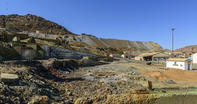Phillips and King
In addition to the Blue Mine at Springbok, the Phillips and King company also secured the leases to several other valuable properties, including Spektakel, Nababeep and O’okiep.

Collectively, they accounted for the bulk of the copper output from Namaqualand, and the company was the most influential player in the region. Their only rival was the Namaqua Mining Company of Von Schlicht and his partners, who owned the nearby Concordia mine. Collectively, the copper mines made a huge contribution to the colony’s balance sheet.
In 1860, copper was the second most important export from the Cape after wool (which was, admittedly, a much more substantial industry).
All the productive copper mines mentioned above were located within a radius of about 30 kilometers, and they each had their ups and downs. Drought, fluctuating copper prices, transport woes, shortage of labour, variable ore qualities and other vagaries caused the mines to increase production, prosper, slow down, wither and grow again in a constant cycle.
The Private Village of Springbokfontein
After the copper boom ended, the two remaining companies, namely Phillips and King, and the Namaqua Mining Company, got busy consolidating their claims and streamlining operations. The Phillips and King group concentrated on their mine at Springbokfontein – the one that had started the whole thing off. Before copper, Springbokfontein was a farmstead with one mud house and couple of mat huts.
Within a few years, it was a bona fide mining station with houses for officers (mainly Cornish miners) and workmen (from all over South Africa). There was also a mess room, storerooms, a wagon maker, a blacksmith, stables, a post office and a prison. Everything in town was built and owned by Phillips and King, and uninvited guests were not allowed to stay overnight in the private village. In several cases, thirsty travellers were denied food and water for their horses.
To Public Springbok

The mine manager (or Super) held supreme power over the inhabitants, often behaving like a dictator. Other officials could also throw their weight around and there is one instance of a resident jailer, Genricks, who terrorised the town before he was finally tried (along with his ‘tame lunatic’) for murder and indecent assault.
Even when Springbokfontein got its first resident magistrate, in 1855, he relied entirely on the company for his accommodation and supplies – hardly conducive to an independent judiciary. The wealth of the Springbokfontein mine was short lived, however, and the mine was exhausted by 1861. Nevertheless, the village had become established and managed to endure. In 1862, the government declared that it was to become a public village.
The town was surveyed by Patrick Fletcher and residential plots were auctioned off. The first clergyman arrived in 1866 and the little mining town developed a social scene, with race meets and balls. Gradually, the village became something of an urban centre for the region. In 1911, the name was shortened to Springbok.
On the Skids
The Blue Mine at Springbokfontein was the first to fail, as we’ve seen, but the settlement was maintained as a municipal centre. A smelter was set up at the old mine in 1866 to process ore from the other Phillips and King mines, although this was later superseded by the reduction works at O’okiep. The company then dealt the town another blow by relocating its headquarters to the more important mine at O’okiep and, by 1877, Springbok was nearly deserted.
Then, in 1881, shipping costs decreased and Springbok mine reopened for another 10 or 15 years. W.C. Scully, the new magistrate, got to work improving the town, often using the prisoners held in the jail as a labour force. By 1904, there are reports that the town was once again on the skids. In 1906, about 100 people lived there.
A school was established in 1911 but, by 1913, the village still had only one hotel. Clothing and lodging were very expensive in Springbok, and some civil servants asked for a transfer because they would’ve gone broke on their current salaries. Still, there was obviously some folk with money because, in 1914 when the first registration of cars in South Africa took place, there were 10 licensed drivers in Springbok (out of a total of 13 for the whole of Namaqualand).
By David Fleminger